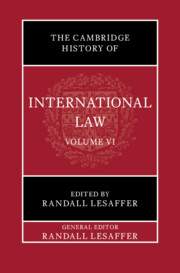Book contents
- The Cambridge History of International Law
- The Cambridge History of International Law
- Frontispiece
- The Cambridge History of International Law
- Copyright page
- Contents
- Plates
- Contributors
- Preface
- Abbreviations
- Part I International Law in Renaissance Europe (1492–1660)
- 1 The Law of Nations in Renaissance Europe
- 2 Territory and Jurisdiction in Renaissance Europe
- 3 Beyond the Free Sea
- 4 War and the Use of Force in Renaissance Europe
- 5 Warfare on Land in Renaissance Europe
- 6 The Law of Maritime Warfare during the Transition between Medieval and Early Modern Europe
- 7 Peacemaking in Renaissance Europe
- 8 Trade and Navigation in Renaissance Europe
- 9 Diplomacy in Renaissance Europe
- 10 Dispute Settlement in Renaissance Europe
- 11 The Ottoman Encounter and the Law of Nations in the Renaissance
- Part II International Law in Old Regime Europe (1660–1775)
- Index
- Plate Section (PDF Only)
- References
9 - Diplomacy in Renaissance Europe
from Part I - International Law in Renaissance Europe (1492–1660)
Published online by Cambridge University Press: 22 April 2025
- The Cambridge History of International Law
- The Cambridge History of International Law
- Frontispiece
- The Cambridge History of International Law
- Copyright page
- Contents
- Plates
- Contributors
- Preface
- Abbreviations
- Part I International Law in Renaissance Europe (1492–1660)
- 1 The Law of Nations in Renaissance Europe
- 2 Territory and Jurisdiction in Renaissance Europe
- 3 Beyond the Free Sea
- 4 War and the Use of Force in Renaissance Europe
- 5 Warfare on Land in Renaissance Europe
- 6 The Law of Maritime Warfare during the Transition between Medieval and Early Modern Europe
- 7 Peacemaking in Renaissance Europe
- 8 Trade and Navigation in Renaissance Europe
- 9 Diplomacy in Renaissance Europe
- 10 Dispute Settlement in Renaissance Europe
- 11 The Ottoman Encounter and the Law of Nations in the Renaissance
- Part II International Law in Old Regime Europe (1660–1775)
- Index
- Plate Section (PDF Only)
- References
Summary
This chapter charts the profound transformations undergone by diplomacy, both secular and papal, in an age of dramatic intellectual, political and military upheaval. Considering both scholarship and practice, the chapter assesses the rise of ‘resident diplomacy’ and highlights the new structures that were put in place in order to manage longer missions. The investigation of the right to send ambassadors reveals persistent traits of pluralism in early modern Europe, while the plurality of diplomatic envoys and roles is taken into account to make the complexity of the notion of diplomatic status more apparent: this status, in fact, cannot be reduced to that of a fully fledged ambassador exclusively committed to the object of their official mission. Information-gathering, negotiation and mediation are singled out as the most significant diplomatic functions. Changes in the conception of diplomatic inviolability and immunity are also considered, and include the emergence of the idea of extraterritoriality concerning both the person of the ambassador and diplomatic premises.
- Type
- Chapter
- Information
- The Cambridge History of International Law , pp. 301 - 328Publisher: Cambridge University PressPrint publication year: 2025

